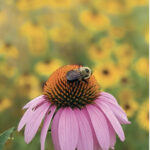 The days are warming, the birds are singing louder. Your personal zing is getting a much-appreciated infusion as it entangles with this awakening. It is a beautiful, chaotic frenzy. Focus and green up the delicious surge of energy!
The days are warming, the birds are singing louder. Your personal zing is getting a much-appreciated infusion as it entangles with this awakening. It is a beautiful, chaotic frenzy. Focus and green up the delicious surge of energy!
If you have plans to plant this year, begin by walking around your property and getting to know it better. I am continually amazed at this exchange with many shoppers.
“Is it sunny or shady in that spot?” I ask.
The answer, more times than you would guess is, “I don’t know. The area is in the front of my house.”
Ummm.
Help turn your thumb greener. Be aware. Are there spots that are excessively dry or wet? Wandering deer? Having personal information about your spot on Earth will increase plant choice success.
There are plants of high value—long-lived, low maintenance, insect- and disease-free, easy to grow and interesting. There are other plants that should only be planted in a horse pasture! These are plants such as short-lived, brittle trees (the poor-quality ornamental pear) and those plants prone to insect and disease problems. Some are fussy about soil or water needs, becoming weaker and prone to issues when their needs are not met. Some are invasive, currently powering through our native woods (this includes the ornamental pear!).
People who know about plants are called “horticulturists.” These garden geeks can help you choose plants based on your site needs and how the plant will react to your conditions and expectations. Be aware. And don’t believe, just because you saw it on the Internet, that it must be true. Talk to your locals.
Turning our attention to expectations…how big do you want the plant to get? What ultimately should be the size of the perfect tree? Did you look up and make sure there are no power lines? How far away from the house should it be?
And don’t ever say, “I’ll be gone before it gets too big.” Really, just don’t. It’s not like a tree can get up and walk over 15 feet due to poor placement. And setting them up for a future of brutal tree topping is awful for the health of the tree—and just plain wrong. Be aware!
This also applies to your shrubbery choices. Don’t say, “Oh, I’ll just prune it when it gets too big.” That translates directly to: “high maintenance.” Choose the proper plant for your spaces. You and your plants will appreciate your extra efforts.
A good garden rant from me has to include the use of chemicals in the garden, with a burst about lawn care.
Eighty percent of chemical misuse is due to homeowners: labels not read, wrong or no identification of the pest, not wearing protective gear. The label is where the dose information is and where the warnings are. If it says two tablespoons will do the job, don’t use two, plus a splash for good luck!
The label often will read “caution,” “warning” or “danger.” (Caution is the lowest threat.) Sometimes, it’s best just to do . . . nothing! Systemic chemicals (imidacloprid) are absorbed by the plant and any insect feeding on it—or drinking from the flowers (our bees, butterflies and hummingbirds)—will ingest it and die. Be aware.
If the bottle says “lasts for 12 months,” that translates to: “This chemical is so sturdy and awful, it takes 12 months for it to go away.” Yikes. Bring a leaf or insect sample to a horticulturist and get the right identification and plan of action.
Lawn care is quite possibly the greatest economic manipulation of our times. We have been led to believe everything that is not a blade of grass is the enemy.
Watch the commercials, and really “see” them—we are waging a war against…dandelions? Really? The bright, yellow flowers are landing pads for pollinators, including bees. The spring fresh foliage is fabulous in salads and is a natural detox (I have recently seen it being sold in grocery stores). Roasted dandelion root tea is also believed to have healing properties and is quite tasty. The big tap root breaks up clay and hard soils.
And the clover? Clover (another bee food source) has the magical ability to pull nitrogen (fertilizer) out of the air and transfer it to the soil. So, we buy chemicals to kill the clover, and then we buy chemicals to fertilize. We kill the dandelions that are making the soil better and buy more grass seed, hoping it will finally take in the terrible soil. And then we worry about what is happening to our beloved bees. Hmm. We aren’t too smart. But the lawn care companies are laughing all the way to the bank.
Don’t be a sheep. Be aware. Let your lawn be a meadow.
Erica Shaffer is a nursery manager with 24 years of experience at Highland Gardens, Camp Hill. She’s also a proud landscape designer, consultant, lecturer, writer, blogger and tree-hugging plant geek. www.highlandgardens.org





